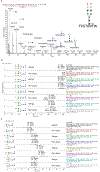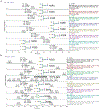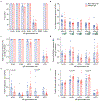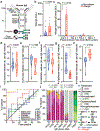Sialylation of immunoglobulin E is a determinant of allergic pathogenicity
- PMID: 32499653
- PMCID: PMC7386252
- DOI: 10.1038/s41586-020-2311-z
Sialylation of immunoglobulin E is a determinant of allergic pathogenicity
Abstract
Approximately one-third of the world's population suffers from allergies1. Exposure to allergens crosslinks immunoglobulin E (IgE) antibodies that are bound to mast cells and basophils, triggering the release of inflammatory mediators, including histamine2. Although IgE is absolutely required for allergies, it is not understood why total and allergen-specific IgE concentrations do not reproducibly correlate with allergic disease3-5. It is well-established that glycosylation of IgG dictates its effector function and has disease-specific patterns. However, whether IgE glycans differ in disease states or affect biological activity is completely unknown6. Here we perform an unbiased examination of glycosylation patterns of total IgE from individuals with a peanut allergy and from non-atopic individuals without allergies. Our analysis reveals an increase in sialic acid content on total IgE from individuals with a peanut allergy compared with non-atopic individuals. Removal of sialic acid from IgE attenuates effector-cell degranulation and anaphylaxis in several functional models of allergic disease. Therapeutic interventions-including removing sialic acid from cell-bound IgE with a neuraminidase enzyme targeted towards the IgE receptor FcεRI, and administering asialylated IgE-markedly reduce anaphylaxis. Together, these results establish IgE glycosylation, and specifically sialylation, as an important regulator of allergic disease.
Conflict of interest statement
Competing interests
The authors declare no competing interests.
Figures










Comment in
-
Does IgE sialylation hold the key to allergy?Nat Rev Immunol. 2020 Jul;20(7):408-409. doi: 10.1038/s41577-020-0364-8. Nat Rev Immunol. 2020. PMID: 32514034 No abstract available.
-
Immunoglobulin E sialylation regulates allergic responses.Immunol Cell Biol. 2020 Sep;98(8):617-619. doi: 10.1111/imcb.12368. Epub 2020 Jul 7. Immunol Cell Biol. 2020. PMID: 32632971
References
Publication types
MeSH terms
Substances
Grants and funding
LinkOut - more resources
Full Text Sources
Other Literature Sources

